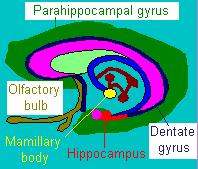27 Aug Brain Correlation Processes

Many computer systems focus on a single capability, one task or just one dimension of a complex process. Sentient brain activity is an example of a complex process with many dimensions. Optical character recognition, such as identifying a capital “Q” on a piece of paper, is an example of a problem with three dimensions: Length, Width and alphabetic knowledge. Each of these dimensions is very simple and very well understood. While some automated systems concentrate on interpreting visual input, others do language analysis, and others evaluate rules to perform analytics. There is nothing out there that performs a broad spectrum of brain tasks — yet.
The Correlating Layer
 The area of the brain surrounding the hippocampus sits at the junction between visual processing and memory. How correlation, interpreting memory and learning occur is still not fully understood, but the role of correlation is essential in the distributed system that is the human brain. A likely role of the hippocampus in cognition is to serve as a contextual map of the environment. When a person is in a familiar place, such as a kitchen or living room, certain sounds will cue attention. The same sounds in a factory, hospital, automobile, or coal mine could well be ignored or not even registered. The environmental map makes possible such feats as disarming the alarm clock without totally waking up or navigating through the house without turning on the lights. Brain correlation permits successful action despite uncertainty. This function will be revisited in later posts.
The area of the brain surrounding the hippocampus sits at the junction between visual processing and memory. How correlation, interpreting memory and learning occur is still not fully understood, but the role of correlation is essential in the distributed system that is the human brain. A likely role of the hippocampus in cognition is to serve as a contextual map of the environment. When a person is in a familiar place, such as a kitchen or living room, certain sounds will cue attention. The same sounds in a factory, hospital, automobile, or coal mine could well be ignored or not even registered. The environmental map makes possible such feats as disarming the alarm clock without totally waking up or navigating through the house without turning on the lights. Brain correlation permits successful action despite uncertainty. This function will be revisited in later posts.
| Understanding Context Cross-Reference |
|---|
| Click on these Links to other posts and glossary/bibliography references |
|
|
|
| Prior Post | Next Post |
| Coordinating Neural Pathways | Layers of Brain Complexity |
| Definitions | References |
| input | Role of the PHC |
| hippocampus | Berne and Levy Cortex |
| artificial neural networks | Bibliography References |

Because of the pivotal role apparently played by the hippocampus in cognition, some artificial neural networks describe a correlating layer as the hippocampus. A correlating layer adds elements of context and memory to a neural network model. This goes on the assumption that prior inputs will assist in interpreting subsequent inputs. In vision and in language processing there is strong evidence that context is essential.
This is a reasonable approach because cognition, recognition, and comprehension are thought to require more activity than occurs solely in the area of the brain that receives and processes the input. Cognition occurs throughout the brain. It also occurs in other parts of the body where hormonal and other chemical reactions constitute a biological response to processes initiated by external and internal input.
Integration & Learning
For humans, learning and other cognitive activities involve the integration of multiple senses. Because of this, it is possible that the cognitive map generated in the hippocampus may integrate more than just the spatial characteristics of the immediate environment. Audio and other sensory cues may be indexed in the hippocampus or another brain area to provide a comprehensive perceptual environment. Because of the tremendous number of sensory stimuli flooding the senses at any given time, cues to assist in filtering out the noise and selecting salient input for cognitive processing may be enhanced by place markers in the hippocampus or other parts of the brain for more than just spatial cues.
 Besides being subconsciously aware of the locations of doors and furniture in a room, we may be subconsciously aware of the sounds, smells, temperatures, and other types of sensory data we would expect to find in certain places. This role is possible because of the vast network of intrinsic links between the hippocampus and other brain components associated with perception and integration.
Besides being subconsciously aware of the locations of doors and furniture in a room, we may be subconsciously aware of the sounds, smells, temperatures, and other types of sensory data we would expect to find in certain places. This role is possible because of the vast network of intrinsic links between the hippocampus and other brain components associated with perception and integration.
I have many upcoming posts for this blog that deal with different psychological aspects of cognition. For each of the eclectic areas I cover, I will include a post that describes how integration of sensory input from multiple sources and stored knowledge contribute to learning. I have posts on sensory processing to describe how the five senses mutually support each other. Other posts will describe how integration of new input and stored knowledge combine to enable interpretation.
| Click below to look in each Understanding Context section |
|---|








